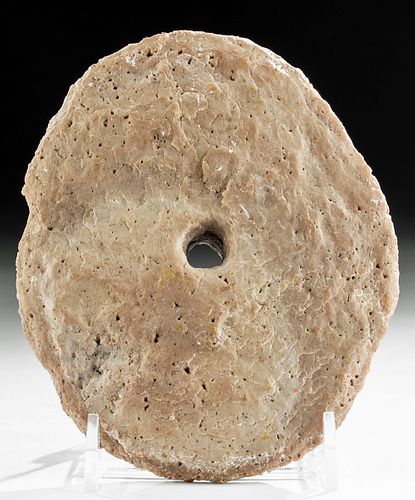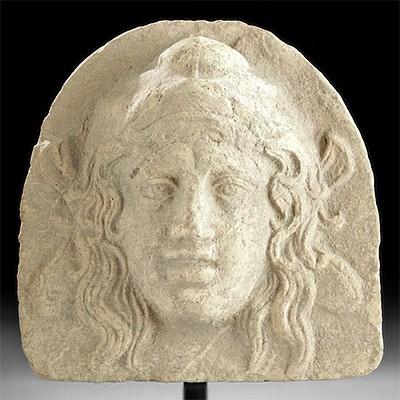19th C. Yap Island Aragonite Pre-O'Keefe Rai Stone
Lot 164
About Seller
Artemis Fine Arts
686 S Taylor Ave, Ste 106
Louisville, CO 80027
United States
Selling antiquities, ancient and ethnographic art online since 1993, Artemis Gallery specializes in Classical Antiquities (Egyptian, Greek, Roman, Near Eastern), Asian, Pre-Columbian, African / Tribal / Oceanographic art. Our extensive inventory includes pottery, stone, metal, wood, glass and textil...Read more
Categories
Estimate:
$1,500 - $2,250
Absentee vs Live bid
Two ways to bid:
- Leave a max absentee bid and the platform will bid on your behalf up to your maximum bid during the live auction.
- Bid live during the auction and your bids will be submitted real-time to the auctioneer.
Bid Increments
| Price | Bid Increment |
|---|---|
| $0 | $25 |
| $300 | $50 |
| $1,000 | $100 |
| $2,000 | $250 |
| $5,000 | $500 |
| $10,000 | $1,000 |
| $20,000 | $2,500 |
| $50,000 | $5,000 |
| $100,000 | $10,000 |
| $200,000 | $20,000 |
About Auction
By Artemis Fine Arts
Feb 27, 2020
Set Reminder
2020-02-27 10:00:00
2020-02-27 10:00:00
America/New_York
Bidsquare
Bidsquare : VARIETY SALE | Antiquities & Ethnographic Art
https://www.bidsquare.com/auctions/artemis-gallery/variety-sale-antiquities-ethnographic-art-4920
Around the world & back in time - be amazed at the treasures you will find. Antiquities from Egypt, Greece, Italy and the Near East, Asian, Pre-Columbian, African / Tribal / Oceanic, Native American, Spanish Colonial, Russian Icons, Fine Art, much more! Artemis Fine Arts info@artemisgallery.com
Around the world & back in time - be amazed at the treasures you will find. Antiquities from Egypt, Greece, Italy and the Near East, Asian, Pre-Columbian, African / Tribal / Oceanic, Native American, Spanish Colonial, Russian Icons, Fine Art, much more! Artemis Fine Arts info@artemisgallery.com
- Lot Description
Oceania, Micronesia, Yap Islands, Pre-O'Keefe style, ca. first half of the 19th century CE. A fine and rare example of a wheel-shaped currency piece known as a "rai" (also raay or fei) with a petite hole drilled through the center. The discoid currency piece has rough faces and an asymmetrical form, with the beautiful beige and smoke hues being characteristic of a type of calcite called aragonite from which all genuine Rai stones are hewn. Rai stones were used as exchangeable currency by the Yapese people, though no movement of larger examples was ever required. The value of an individual rai stone is based both on the overall craftsmanship as well as the oral history of ownership. Ownership of each stone was used as payment or exchanged for goods and services, unusual favors, purchasing homes or plots of land, or as part of a bride price dowry. Lucite display stand for photography purposes only. Size: 5.2" L x 4.375" W (13.2 cm x 11.1 cm)
Rai stones from the Yap Islands are some of the most intriguing types of currency in the world and represent an intriguing interpretation of the definition for 'money.' According to author and traditional currency expert Charles Opitz, "The larger stones were displayed and in many cases were displayed outside the bachelor's house to show the wealth of the village. The stones had no practical non-monetary use other than as ornamentation. The stones were also used for political payments. A large stone could be used to buy support of a neutral tribe during a war. The German government set fines in stone money. The stone money was purely an internal money and was never used to trade with other islands." (Opitz, Charles. J. "An Ethnographic Study of Traditional Money: A Definition of Money and Descriptions of Traditional Money." First Impressions Printing, Florida, 2000, p. 319)
For a strikingly similar example with a braided thread handle through the center, please see: Opitz, Charles. J. "An Ethnographic Study of Traditional Money: A Definition of Money and Descriptions of Traditional Money." First Impressions Printing, Florida, 2000, p. 317, bottom row, center example.
Provenance: private J.H. collection, Beaverton, Oregon, USA, acquired between 2014 and 2015
All items legal to buy/sell under U.S. Statute covering cultural patrimony Code 2600, CHAPTER 14, and are guaranteed to be as described or your money back.
A Certificate of Authenticity will accompany all winning bids.
We ship worldwide and handle all shipping in-house for your convenience.
#151908Minor chips and abrasions to faces and peripheries, otherwise intact and very good. Light earthen deposits throughout.Condition
- Shipping Info
-
All shipping is handled in-house for your convenience. Your invoice from Artemis Gallery will include shipping calculation instructions. If in doubt, please inquire BEFORE bidding for estimated shipping costs for individual items.
-
- Buyer's Premium



 EUR
EUR CAD
CAD AUD
AUD GBP
GBP MXN
MXN HKD
HKD CNY
CNY MYR
MYR SEK
SEK SGD
SGD CHF
CHF THB
THB













